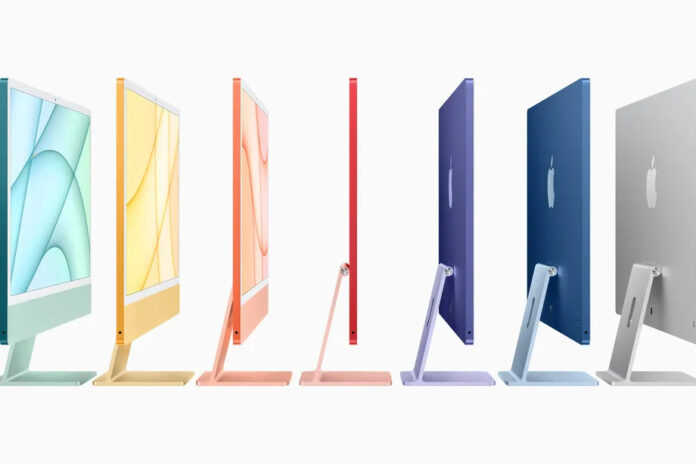Apple introduced a redesigned iMac today with a slimmer display, an Apple Silicon chip, and a case with bright, bold colors that throws back to the classic colorful all-in-one iMacs. Apple said the new iMac was designed from the ground up for the M1 chip.
The new iMac has a 24-inch, 4.5K display with narrower borders around the top and sides. It still has a large chin on the bottom, but the rear of the display is now flat instead of curved. Apple says the volume has been reduced by over 50 percent. The screen also has Apple’s True Tone tech for automatically adjusting the color temperature.
Apple is also promising a much-needed update to the iMac’s camera and mics so you’ll look better on video calls. It now has a 1080p resolution and a larger sensor.
:no_upscale()/cdn.vox-cdn.com/uploads/chorus_asset/file/22457424/138_2021_04_20_138_vlcscreen.jpg)
The new iMac is 11.5mm thin, but Apple says it should stay quieter and cooler than the previous model, thanks to the M1 chip. The new model has “two small fans” replacing the “bulky thermal system” of the previous-generation iMac, the company says.
There’s also a new magnetic power cable — it sounds a lot like the old MagSafe cable — that attaches to the back. Ethernet can be connected to the power brick and delivered through the same cable. The entry-level model will come with two USB-C / Thunderbolt ports on the back, and a higher-end model will add an additional two USB-C ports (without Thunderbolt support). Incredibly, there is still a headphone jack.
:no_upscale()/cdn.vox-cdn.com/uploads/chorus_asset/file/22457431/134_2021_04_20_134_vlcscreen.jpg)
:no_upscale()/cdn.vox-cdn.com/uploads/chorus_asset/file/22457430/133_2021_04_20_133_vlcscreen.jpg)
:no_upscale()/cdn.vox-cdn.com/uploads/chorus_asset/file/22457429/132_2021_04_20_132_vlcscreen.jpg)
Alongside the new iMac, Apple is also introducing a keyboard, mouse, and trackpad in colors to match. The keyboard has a Touch ID button for logging in.
The new iMac starts at $1,299, though some of the colors are reserved for the higher-end $1,499 model. It’ll be available in the second half of May, with orders starting April 30th. There are seven color options total. The base model comes with 8GB of RAM and a 256GB SSD; it can be upgraded to include up to 16GB of RAM and 2TB of storage.
This is the first iMac to switch to Apple Silicon, the chips that Apple has been designing in-house. The company first added an Apple Silicon chip to the MacBook Air, MacBook Pro, and Mac mini in November. Apple plans to eventually roll out these Arm-based chips to its entire Mac line. While the transition means that macOS software needs to be updated to support the new chips, so far the trade-offs have been worth it. The first generation of M1 Macs have been extremely well-received, with the new chips offering improved power and battery life.
Related:

















![EC Announces Elimination of Indelible Ink in Upcoming Elections [Video]](https://newsonghana.com/wp-content/uploads/2023/12/image-351-218x150.png)










































